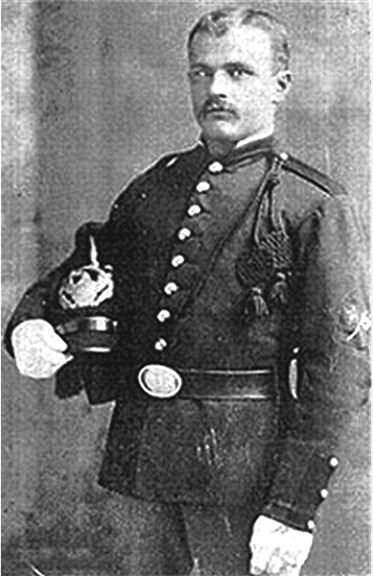|
MODEL 1891 SIGNAL CORPS ENLISTED MAN’S DRESS
HELMET – A RARE SPECIMEN IN EXCELLENT CONDITION:
The Signal Corps was one of the smaller branches of the
Indian War era Army, resulting in a low survival rate of
their distinctive Model 1891 Dress Helmets. The orange
trimmed Model 1881 Signal Corps Dress Helmets were
discontinued in 1889, and this black trimmed dress
helmet was adopted for enlisted Signalmen in 1891.
Due to most of the soldiers and officers of the corps
being assigned individually or in small detachments in
support of the Artillery, Cavalry and Infantry
regiments, much of their contribution throughout the
American West during the Indian Wars has passed
unnoticed, albeit unfairly.
In addition to
communicating on the battlefield via the use of the
semaphore flags that are featured in their 19th
Century insignia, the Signal Corps also staffed
telegraph stations and telephone exchanges in some of
the larger metropolitan areas. In 1870,
through an act of Congress, the Signal Corps then under
the command of General Myers, was tasked with recording
meteorological observations at the military posts
throughout the nation and its territories, and via
telegraph providing alerts of the approach and force of
developing storms. This assignment was the birth of the
U.S. Weather Bureau, and in 1873 while attending the
International Meteorological Congress of Vienna, General
Myers proposed a resolution establishing a world wide
network of weather stations and providing for a daily
exchange of weather observations – effectively the
genesis of the World Meteorological Organization.
Arguably, the most renowned performance of the Indian
Wars-era Signal Corps was the successful use of the
heliographs which were employed against the Apaches
during the campaigns in the Arizona Territory. Having
established a chain of heliograph stations posted on
prominent mountain peaks throughout the area of
operations, observers were able to rapidly communicate
the position, numbers, and activities of the renegade
Apaches and by using this timely information, the field
commanders could deploy their troops to contain and
intercept the raiding parties.
US Army Signal Corps soldiers manned these lonely
stations to great effect and one such soldier, Sergeant
Will Croft Barnes, became one of only five Signal
soldiers to have received the nation’s highest award,
the Medal of Honor, for his actions at Fort Apache,
Arizona Territory. On August 29, 1881 the Fort Apache
commander, Colonel Eugene A. Carr, set out with a column
to arrest a medicine man at a village on Cibecue Creek.
Barnes remained behind at the fort with about 70 other
soldiers and civilians who were isolated due to the
Apaches having cut the telegraph lines. Uncertain about
the status of Carr's expedition which was rumored to
have been destroyed, Barnes volunteered to climb a
nearby 2,000 foot mesa alone and use his signal flags to
alert the post to any threatening Indian activity.
Instead of Indian movements, Barnes was able to signal
the return of Carr's column. During further operations,
Barnes found himself involved in several skirmishes
while continuing to get messages through via mounted
courier. Barnes’ abilities as a soldier and signalman
impressed his superiors who described him in the
recommendation for the Medal of Honor as being “prompt
and unhesitating in the discharge of all duties assigned
to him, more than once being exposed to great danger.”
Sgt. Barnes is captured in the image below wearing his
dress uniform, albeit that the sleeve of his dress coat
bears the Signal Corps brassard comprised of the two
crossed signal flags, the predecessor to the addition of
the burning torch to the insignia in 1885. He holds his
plumed Model 1881 Signal Corps Dress Helmet with the
helmet cords arranged properly around the collar of his
coat and secured to the epaulet button with the waffles
and tassels hanging down over his chest. Note that the
orange plume and cords, like the Cavalry yellow plumes
and cords, appear black in these period images – a
function of the photography process of that era.
Although Barnes is wearing the earlier version of the
Signal Corps Dress uniform and helmet, this image
documents the dress uniforms of these specially trained
soldiers on the frontier.

This specimen of the Model 1891
Enlisted Man’s Signal Corps Dress Helmet is in excellent
condition. Complete with all of the original correct
trimmings and insignia, to include the plume, plume
holder, side buttons, rings, the proper staff eagle
plate with the German silver Signal Corps insignia
overlay, and of course an excellent helmet body.
The Signal Corps overlay on the eagle plate and the
insignia on the side buttons is the Signal Corps
insignia adopted in 1885 which included the burning
torch with the crossed signal flags.
The helmet body is full form with no crushing, breakage,
loss of finish or other damage. The inside surface of
the sweat band retains the legible maker’s contract
stamp – “ C.J. HELLER, PHILA”. The original size paper
tag is still present at the rear of the sweat band.
The original plume and set of cords on this helmet are
in excellent condition. The plume falls gracefully over
the helmet with no tangles. The cords are complete with
all the trimmings and both sets of waffles and tassels,
and the cords are strong with vivid color and no
significant snags from being worn.
This is an outstanding example of the relatively rare
Signal Corps Dress Helmet of a quality seldom
encountered on today’s market and it is one that would
deserve to be displayed as a centerpiece in your
collection.
SOLD
If
you are thinking in terms of a Signal Corps display, you
might want to consider an excellent, complete Heliograph
Set I have listed under "FIELD EQUIPMENT" which you can
view by clicking
here
and a Signal Corps
Corporal Chevron worn concurrent with this helmet that
you can view by clicking
here.
|

